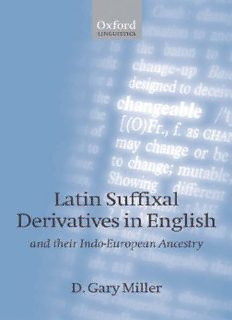
Latin Suffixal Derivatives in English: and Their Indo-European Ancestry (Oxford Linguistics) PDF
Preview Latin Suffixal Derivatives in English: and Their Indo-European Ancestry (Oxford Linguistics)
Y Latin Su xal Derivatives in English and their Indo-European Ancestry This page intentionally left blank Y Latin Su xal Derivatives in English and their Indo-European Ancestry D. GARY MILLER 1 3 GreatClarendonStreet,Oxfordox26dp OxfordUniversityPressisadepartmentoftheUniversityofOxford. ItfurtherstheUniversity’sobjectiveofexcellenceinresearch,scholarship, andeducationbypublishingworldwidein Oxford NewYork Auckland CapeTown DaresSalaam HongKong Karachi KualaLumpur Madrid Melbourne MexicoCity Nairobi NewDelhi Shanghai Taipei Toronto WithoYcesin Argentina Austria Brazil Chile CzechRepublic France Greece Guatemala Hungary Italy Japan Poland Portugal Singapore SouthKorea Switzerland Thailand Turkey Ukraine Vietnam OxfordisaregisteredtrademarkofOxfordUniversityPress intheUKandincertainothercountries PublishedintheUnitedStates byOxfordUniversityPressInc.,NewYork (cid:1)D.GaryMiller2006 Themoralrightsoftheauthorhavebeenasserted DatabaserightOxfordUniversityPress(maker) Firstpublished2006 Allrightsreserved.Nopartofthispublicationmaybereproduced, storedinaretrievalsystem,ortransmitted,inanyformorbyanymeans, withoutthepriorpermissioninwritingofOxfordUniversityPress, orasexpresslypermittedbylaw,orundertermsagreedwiththeappropriate reprographicsrightsorganization.Enquiriesconcerningreproduction outsidethescopeoftheaboveshouldbesenttotheRightsDepartment, OxfordUniversityPress,attheaddressabove Youmustnotcirculatethisbookinanyotherbindingorcover andyoumustimposethesameconditiononanyacquirer BritishLibraryCataloguinginPublicationData Dataavailable LibraryofCongressCataloguinginPublicationData Dataavailable TypesetbySPIPublisherServices,Pondicherry,India PrintedinGreatBritain onacid-freepaperby BiddlesLtd,www.biddles.co.uk ISBN0–19–928505–5 978–0–19–928505–1 1 3 5 7 9 10 8 6 4 2 To my family: Judith, Blair, and Scott This page intentionally left blank Preface AimandCoverage The objective of this work is to provide a reliable taxonomy and brief historicalaccountofthemajorLatinsuYxalderivativesinEnglish. An updated treatment has been needed because (1) more is currently knownaboutthehistoryandprehistoryoftheLatinsuYxesthanpreviously; (2)EnglishhashadoveramillenniumofcontinuousinputfromFrenchand Latin; (3) the complexity of the competition between native and borrowed suYxes in English has received considerable recent attention; and (4) Latin remainsaproductivesourceofEnglishwordformation. Themostnotablefeatureofthisworkisitscoverage.Thenumberoftokens for each suYx far exceeds that of every treatise on borrowed suYxes in existence.NootherworkconcentratesonwordformationpatternsinEnglish thatareduetoborrowingfromLatin. Another unique feature is the loyalty to Latin derivational patterns and their development. This increases the utility for classicists, forms a basis for the study of the diVusion of classical elements in the vernaculars of Europe, andemphasizestheformalvariationinwhichthesamesuYxoranalternant ofitenteredEnglishatdiVerenttimesviadiVerentchannels. English is rich in derivational suYxes as a result of its Germanic heritage overlainbytheLatin-Frenchinput.Insomecases,theborrowedsuYxeswere diVerentincontentfromthenative,butinotherstherewascompetitionfora domain of productivity. While this is discussed in the introductory remarks onrelevantsuYxes,intermediatesourcewords,mostfrequentlyOldFrench/ Anglo-French,1 are minimized since they are cited in most etymological dictionaries and the OED. Instead, this work focuses on information about theLatinformsandtheirhistory thatisignoredinetymologicaltreatises. Each suYx is accompanied by a brief note on its Indo-European or other ancestrywhenknown.ThediscussionthatetymologicaldictionariesofEng- lishwordssupplyforrootoriginsisthusprovidedforthehistoryofsuYxes. This information is followed by a sketch of the suYx’s synchronic status in Latin, and a statement concerning its relative productivity in English. Since 1 IusethetermAnglo-FrenchratherthanAnglo-Normanbecause,fromthetimeofthe‘Norman’ invasion,theFrenchspeakersinEnglandrepresentedmixeddialects(Rothwell1993,1994,1996a,1996b, 1998). viii Preface Modern English is targeted throughout, lists of borrowings contain the earliest examples that survive into present-day English and a sample of the moreprominentlaterexamples. Intheinterestofspace,thefullpre-Latinbackground(whenknown)isnot repeated with every example. For the most part, the prehistory is cited with only one entry that belongs to a given Indo-European root. That entry is markedwithanasterisk(*)inthewordindexandcross-referencedintheroot indextoothermembersofthesameroot. Each lemma is accompanied by an approximate date of the word’s Wrst occurrence in English and the relative date of the source word within the historyofLatin. EtymologicalDictionaries Of the numerous resources available for the study of etymology, two in particular are useful as Wrst steps in an enquiry. These are Terry Hoad’s ConciseOxfordDictionaryofEnglishEtymology(CDEE)andCalvertWatkins’s American Heritage Dictionary of Indo-European Roots (AHDR). Both are remarkable for the amount of information in a small space. For words borrowed from Latin or Greek, Hoad gives the general classical source, an Old French or other intermediary (when relevant), brief word histories in English, and broad Wrst dates of occurrence for the main changes in usage/ meaning.WatkinsprovidesmoredetailontheIndo-Europeanbackgroundof inheritedwords,andotherwordsthatbelongtothesameroot.Noneofthese provides discussion of the derivation of the Latin source word. Ernout and Meillet(1951)andWaldeetal. (1982)havebeenconsultedthroughout.Since thelatterisutilizedbyallrecentworks,citationsareminimized. CitationofIndo-EuropeanRoots ThegeneralknowledgeofIndo-Europeanassumedherecanbefoundinany of the handbooks. Especially useful are Benjamin Fortson’s Indo-European Language and Culture (2004) and Michael Meier-Bru¨gger’s Indo-European Linguistics(2003). Because of its ready accessibility, all Indo-European roots in the present workarecitedasinWatkins(AHDR)unlessotherwisespeciWed.Generally,an older Proto-Indo-European (PIE) form is also provided, sometimes from AHDRandsometimesfromothersources,especiallyRixetal.(2001),Lexikon der indogermanischenVerben(LIV). Preface ix Indo-Europeanrootsinanentryarecitedinbrackets,theWrstfromAHDR (unspeciWed), the second (if present) from LIV, e.g. L valee(cid:1)re ‘be powerful’ [*wal-‘bestrong’¼*welh-1LIV676f.].Inmanycases,ashere,theLIVentry is simply the older PIE form. Since the roots are alphabetized in AHDR, no page reference is necessary unless a speciWc discussion is referred to. Page numbers are given for LIV roots, which are also alphabetized, but more diYcult to locate given the separate listings for palatals, aspirates, speciWc laryngeals,etc. Frequently the root in AHDR is a theoretical abstraction and a more speciWc root formisgivenbyLIV, e.g. L tum-ee(cid:1)-re‘to swell’[*teu(h2)-‘swell’, morespeciWcally*twem-LIV654].TheLIVentry inthiscaseiscloser tothe protoformoftheLatinwordinquestion. I have taken the liberty of making certain substitutions in the interest of consistency and clarity. For AHDR’s obsolete *e, the appropriate laryngeals (*h1, *h2, *h3) have been substituted; *h without a number means that the precise nature of the laryngeal is undetermined. Many of the diacritics in LIVhavebeenaltered,especiallyi/y,u/wfortheeditors’*i,*u,e.g.*wyekw-(¼ *uieku-LIV696),*yeug-(¼*ieug-LIV316). ˆ ˆ ˆ ˆˆ ˆ ˆ When AHDR’s ‘oldest form’ and LIV’s form is the same, a single form ´ can be cited without reference, e.g. *spek- ‘observe’ for ‘*spek- ‘‘to observe’’. (Oldest form *spek´-)’ (AHDR 82) ¼ *spek´- (LIV 575f.). Sometimes, for simplicity, just the LIV form is cited, e.g. *g´enh 1- ‘beget’ instead of AHDR’s *gene-.SinceAHDR(aloneofmodernsources)uses*eandonlycitespalatals as the ‘older form’, it is clear that *g´enh 1- (with palatal *g´ and speciWed laryngeal)mustbefromLIV(and/orAHDR’s‘olderform’). Another(perhapspeculiar)conventionIhavefollowedistowritetheIndo- European aspirates merely as *bh, dh, g´h, gh, gwh, except when adjacent to a laryngeal. The zero grade of *deh3- ‘give’ is written *dh3-, but to avoid potentialconfusion,thatof*dheh1-‘put;make’iswritten*dhh1-withvoiced aspiratesignalledbysuperscripth. For roots not in AHDR or LIVand, more generally, whenever available, another source of background discussion is supplied, preferably in an English-languagesource.SemiticrootsarecitedfromHuehnergard(2000). Acknowledgements Partsofthisworkhavebeenpresentedatconferencesandcolloquia,andother parts read by friends and colleagues. For discussion of particular words or topics,IamindebtedtoRobAdams,PhilBaldi,DavidBasilico,yDanielleBro,
Description: